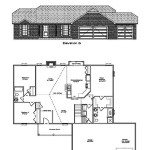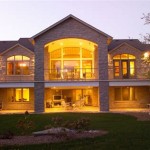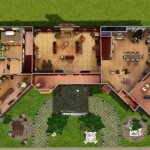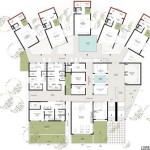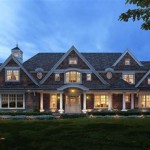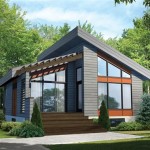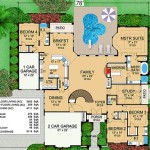Essential Aspects of a Full House Floor Plan
A full house floor plan is a diagram that showcases the layout and arrangement of a house. It's a crucial aspect of home design, as it determines the functionality, flow, and overall livability of a home. Here are essential aspects to consider when creating a well-thought-out full house floor plan:
1. Room Placement: The placement of rooms within a floor plan is paramount. Factors to consider include privacy, natural light, and accessibility. Bedrooms should be located in quieter areas for privacy, while living areas and kitchens should be situated to maximize natural light and provide convenient access to outdoor spaces.
2. Flow and Circulation: A good floor plan ensures smooth flow and circulation throughout the house. The layout should allow for easy movement between rooms, without creating bottlenecks or dead-end spaces. Consider the direction of traffic flow and create clear paths for movement.
3. Size and Proportions: The size and proportions of rooms are integral to functionality and comfort. Each room should have sufficient space to accommodate its intended use and furniture. Proportions play a role in creating balance and visual appeal in a home.
4. Adjacencies and Relationships: Adjacencies refer to the placement of rooms relative to one another. For example, kitchens should be adjacent to dining areas, and master bedrooms should be connected to separate bathrooms. Proper adjacency minimizes travel distances and enhances convenience.
5. Storage and Built-ins: Ample storage is essential for maintaining a tidy and organized home. Consider built-ins within walls or closets to maximize space and eliminate clutter. Closets and pantries should be strategically placed to provide convenient storage solutions.
6. Natural Light and Ventilation: Natural light not only brightens a home but also contributes to energy efficiency. Orient windows and skylights to maximize daylight exposure. Proper ventilation is crucial for maintaining healthy indoor air quality and comfort.
7. Outdoor Living Spaces: Seamless connections between indoor and outdoor spaces enhance livability and expand the living area of a home. Consider porches, patios, or decks that provide access to outdoor areas and extend the entertainment and relaxation space beyond the house.
8. Home Technology: Modern full house floor plans often incorporate home technology systems. Consider the placement of wiring, outlets, and smart home devices to enhance convenience and comfort. Plan for future technological advancements by ensuring flexibility in the layout.
9. Accessibility and Universal Design: Creating an accessible home is essential for individuals with disabilities or age-related limitations. Consider features such as wide doorways, ramps, and accessible bathrooms to ensure a comfortable and independent living environment.
10. Future Expansion and Flexibility: A well-conceived floor plan should anticipate future expansion or changes in lifestyle. Make provisions for potential additions or reconfigurations by leaving extra space or creating flexible walls that can be modified as needs evolve.

Pin By Madame On House Inspiration Sims Design Floor Plans Layouts

Full House Tv Show Floor Plan Fuller Layout Tan

Full House Floor Plan Sitcoms Message Boards Forums Plans Layouts

The House Full Forever

Fun Facts About Full House And The Tanner Family S Victorian Floor Plans

Full House Sitcom Tv Show Floor Plan

The House Full Forever

Famous Tv Show Floor Plans House Nerd

The House Full Forever

The Full House Victorian In San Francisco Today

